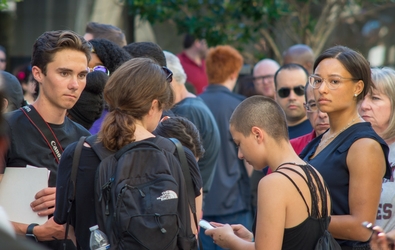Last month, students publicly advocated for tighter gun control laws after surviving one of the world’s deadliest school massacres in Parkland, Fla. Standing in front of politicians, reporters and large crowds in major cities across the country, kids quickly transformed from victims to public relations advocates. Their efforts initiated the #NeverAgain movement, inspiring public rallies, student protests and changes to gun policies at some of the nation’s largest retailers.
Here is one perspective to explain how these students created such a successful public relations campaign.
Timing
On the day of the shooting, surviving students turned to social media to express their grief, disbelief and anger for what happened, creating and sharing group pages to call out the systems that allowed this tragedy to happen.
“People are listening and people care,” wrote Cameron Kasky, 17, a junior at Marjory Stoneham Douglas High School, after his social media posts led to an invitation to submit an op-ed to CNN.com and subsequent televised interviews. “They’re reporting the right things.”
Students acted fast. Within days of the tragedy, the #NeverAgain movement was activated, a policy goal was put in place, action items were determined, and teens gave interviews for major news outlets nationwide.
In public relations, timing is everything. You could have the most brilliant idea to share with the world, but if your idea doesn’t seem relevant to the day’s topics and trends, your idea will fall on deaf ears.
Messaging
Surviving students became storytellers, bravely sharing their experiences. Not only did they put a face to the mission, which pulls at the heartstrings, but they also left adults with a clear call to action: stop sending thoughts and prayers and start taking action to stop gun violence and save lives. They advocated for more strict background checks for gun buyers as they grieved with their community.
Celebrities, such as Lin-Manuel Miranda and Ariana Grande, lent their talents and social media platforms to amplify the message. Some even marched. As media coverage increased and lawmakers, parents, educators, more students and even the NRA spoke out, news stories added third party credibility to the growing movement.
Having one unified and clear message is crucial for a successful PR campaign. Having authentic and passionate spokespeople to deliver that message and outside validation for the work is that much more powerful.
Action
On March 24, teens across the country led 17 minute protests, in honor of each of the victims, during March for Our Lives. The monumental event even mobilized protestors abroad and proved younger generations are an influential force to create meaningful change.
Gun store owners reported an abrupt decline in sales. Corporations, namely Dick’s Sporting Goods and Walmart, raised the minimum age to purchase guns. Just last week, New England Patriots player Julian Edelman and his assistant prevented a potential school shooting by reporting a threat left in the comments section of his Instragram page that was brought to his attention by a concerned follower after which authorities arrested a 14-year-old male who admitted to writing the post and had access to two guns in his house.
Edelman told the New York Times, he immediately thought of Parkland when he read the comment. He thanked the kid who spoke up to let him know about the comment. Conversations continue about gun control laws and more changes are to come thanks to the actions of the teens who started #NeverAgain.
This is how you use public relations for the greater good.


